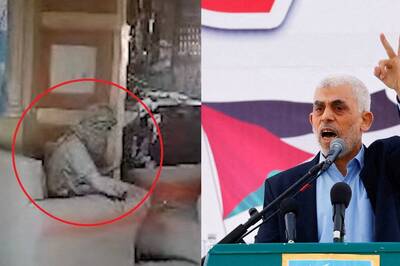
views
Delhi has no full stops and is not at all a static city. This was something which acted as the governing principle for Sheila Dikshit, the Congress leader who ruled the city for three consecutive terms as its chief minister from December 1998 to December 2013, and passed away on Saturday, fighting a battle to revive the fortunes of her party as president of its Delhi unit.
The first reaction of people on hearing of her demise was that the city is going to miss her. Dikshit closely identified with Delhi and carried out her work with an extraordinary passion, never distracted with any ambition to look beyond the precincts of the city government.
The development of the capital for her was defined by two parameters — make Delhi into a world-class city but also get for it the tag of a ‘Heritage City’.
“Development is not only about cement and concrete, but also a definite change in the social ethos, which would make the society move towards a progressive thought process and open-mindedness. Such a thought process should also get reflected in the building of the infrastructure, and that was what my government tried to achieve. It needed a lot of effort and balancing act but we could manage it," the leader had recounted in a recent personal tête-à-tête.
Born to an Army officer in Kapurthala, Sheila Dikshit was educated in Delhi at Jesus and Mary Convent and Miranda House. She completed Master’s degree in History and married her college-time beau Vinod Dikshit, who was a student at St Stephen’s College. Vinod was the son of noted freedom fighter Uma Shankar Dikshit, a former Union minister who was the backbone of the Congress organisation. However, on joining the Indian Administrative Service (IAS), the son remained aloof from Congress politics.
Vinod was from the Uttar Pradesh cadre, which was also his father’s turf, but maintained a discreet distance. In fact, Vinod was greatly trusted by the Lok Dal leader and former prime minister Chowdhary Charan Singh, who had also served as Uttar Pradesh chief minister for some time.
As a government officer, Vinod worked by rising above ideologies. He remained a close aide of another UP chief minister, Chandra Bhanu Gupta, who was Uma Shanker Dikshit’s political rival. Objectivity in governance was an article of faith with Vinod and for Sheila as well as it was reflected in her dealing with Delhi’s bureaucracy, which works under multiple commands.
Sheila was pitchforked into the city’s politics in 1998 when asked by party president Sonia Gandhi to contest the Lok Sabha polls from East Delhi seat. From almost a state of political hibernation, she now had a colossal task to perform. This huge constituency with 20 assembly seats for long had remained a pocket borough of Congress veteran Har Kishan Lal Bhagat before he lost in 1991. Thereafter, the BJP managed to turn this seat into its stronghold, winning it again in the 1996 general elections and the 1997 by-polls.
Sheila was asked to test the waters from the seat despite it having several claimants from Bhagat’s political stable and the veteran himself not having given up. The media, too, did not give her much of a chance, with screaming headlines asking, “Sheila who, Dikshit or Kaul". Sheila Kaul was a minister in the PV Narasimha Rao government and had remained in the news for several scams attributed to her office.
Despite the adverse prevailing situation and a definite pro-BJP mood among the electorate, Sheila managed to give sitting MP Lal Bihari Tiwari a run for his money. She mobilised a ramshackle organisation and polled 5,17,721 votes — till then the highest ever by any Congress leader on any seat in Delhi. Although she lost, the party leadership was convinced that it had found the person to revive the Congress in the national capital.
In less than six months, Sheila was asked to take charge at the dilapidated Talkatora Road office of the Delhi Pradesh Congress Committee as its president with the almost insurmountable challenge to defeat the BJP in the Assembly polls scheduled for the end of the year.
Sonia Gandhi, by now, was in firm command of the party, with leaders from erstwhile Congress (Tiwari) such as Arjun Singh, ML Fotedar and K Natwar Singh playing important roles. Since Sheila was also part of Congress (Tiwari), there was no doubt in the mind of party workers that she enjoyed the leadership’s absolute backing and they closed ranks behind her.
In less than three months, focusing on the issue of mal-governance of the city and the spiraling prices of onion, Sheila set panic in the BJP camp. Meanwhile, there was infighting in the ruling party between the Madanlal Khurana and Sahib Singh Verma factions. Khurana had demitted the chief minister’s office a few years before after being named in the Jain Hawala case. Now exonerated, he wanted the post back, which the incumbent Verma resented.
Caught in a cleft stick, the BJP leadership brought in Sushma Swaraj, Lok Sabha member from South Delhi, as chief minister. They thought they would kill two birds with one stone — end the factional feud and pitchfork a woman against a woman in the approaching polls.
“It proved counter-productive. In political battles, it’s important that you first and foremost have the confidence and the goodwill of political workers. If they are with you, the voter also gets galvanised. Poor Sushma had nothing working for her, I felt bad for her. Though she was an opponent in the battle, I respected her as an emerging woman leader in the party not known to be very favourably deposed towards womenfolk," Sheila had said.
On that December morning in 1998, when chill had just started to set in, BJP candidate and sitting MLA from Gole Market Assembly seat, Kirti Azad, a burly former national cricketer, hugged the diminutive Sheila at the Navodaya School counting booth and said, “Bua (aunt), you have won."
Kirti Azad, son of Congress veteran Bhagwat Jha Azad, a former Bihar CM, who had joined Congress (Tiwari) as had Sheila, when it was formed in 1994.
Outside in the corridor, the Congress strongman from Outer Delhi Sajjan Kumar was talking loudly to reporters with a keen eye that his baritone voice would register with Sheila as well.
“Mere 12 MLA toh Sheila ji ke liye hain (My 12 MLAs are for Sheila)," he had said, setting the ball rolling for the appointment of the next chief minister. Having been trained in politics under the tutelage of her father-in-law Uma Shanker Dikshit, Sheila knew how to react in such situations.
Upon leaving the counting booth, Sheila took compliments from workers and told her son Sandeep, who had then taken a break from his work in Bhopal, to manage her campaign. “I am going to meet Sonia ji, you please remain with the workers," she told him. The statement that morning reflected the fine balance she managed between the party leadership and political workers.
The victory had not come alone on the spiraling price of onion, although its role cannot be denied. In the little time she had in the Delhi Congress, Sheila broke stereotypes. She gave tickets to a mix of youth leaders, established workers, educated persons and a fair number of women. They made a very enthusiastic team, each trying to outperform the other on their respective turfs. This enthusiasm paid rich dividends as the Congress turned the tables on the BJP, bagging 52 of the 70 seats and more than 47% of the vote share.
On taking over as chief minister, Sheila gave a very positive message to the bureaucracy. She appointed S Reghunathan, an important functionary in the outgoing government, as her principal secretary. Reghunathan was to remain a very strong bureaucrat for the large part of her tenure, rising to become the chief secretary.
On her appointing Shakti Sinha, a private secretary to then Prime Minister Atal Bihari Vajpayee as her government’s powerful principal secretary of finance and power, Sheila had an interesting point to make.
“He (Shakti Sinha) had tremendous exposure working in the PMO (Prime Minister’s Office) and why should I have lost out on utilising his experience when I got the opportunity?" Sheila, who had worked as minister in-charge of the PMO during Rajiv Gandhi’s term, had asked. Despite the cadre-control of the officers with the central government and the Lieutenant Governor, their personal loyalty to Sheila remained legendary.
If the bureaucracy had not come along, she would not have delivered on the Delhi Metro, the 75-odd flyovers, including elevated roads and several underpasses, water pipelines that were several kilometers long, numerous hospitals, several college buildings, new universities, a new fleet of buses, social security schemes, cultural verticals, and so on. The bureaucracy was integrated as part of her vision — she trusted them and they delivered.
Sheila’s famous citizen partnership programme — Bhagidari (partnership) — was not just the name of a government scheme but the driving force of her tenure. For those 15 years, citizen groups worked as partners, received the best inputs for the city, and delivered services in the best possible way. She achieved the unimaginable as the people and the bureaucracy worked together to turn Delhi into a city of hope and aspiration.
The Bhagidari project earned accolades at the national and international levels and even received recognition from the United Nations. She extended this partnership at the level of inter-government interaction as well. Sheila managed to get the best from the Atal Bihari Vajpayee government at the Centre with LK Advani as home minister and Vijai Kapoor as the Lieutenant Governor. The BJP-ruled MCDs, too, really did not have much to complain against her government.
“There was also a concerted effort to convert the Delhi assembly from being a debating society into a serious legislative body. I told my MLAs that if there was quality in debate, people would have to take us seriously. My stint as parliamentary affairs minister in Rajiv Gandhi’s government came in handy. I admired and patiently listened to speakers like Jagdish Mukhi, Harsh Vardhan and later Vijay Kumar Malhotra from the Opposition bench," Sheila had said, adding, “Outside the house, there were Sahib Singh Verma and Madanlal Khurana, always ready with their incisive criticism, which I took sportingly."
On what remorse she carried from her long tenure, Sheila had said the successful organisation of the 2010 Commonwealth Games did not get its due recognition. The foreign participants and delegates had said that a better tournament had not been organised in the history of the CWG. It gave Delhi a major boost in infrastructure. But what followed was a campaign of slander — she came out of it clean despite committees being set up to investigate her. Delhi today survives on the infrastructure built for the Commonwealth Games.
What should have been celebrated was drowned in the cacophony created by the Anna Hazare movement. The press went to town about the collapse of a small pedestrian bridge, but none talked about the Barapullah elevated corridor. Sheila also lost in the polls.
It was not that mere support of the Gandhi family ensured a smooth ride for her within the party. Dissidence raised its head in the early years of her tenure. Fresh blood had been infused into the party; the old guard was reluctant to give space. A struggle had to ensue and Sheila was prepared for it, and resolved it in her own manner.
Rivals like HKL Bhagat, Jagdish Tytler and Chowdhary Prem Singh were virtually sidelined and slowly faded away. Sheila held her ground in dealing with AICC functionaries like Ahmed Patel, Kamal Nath and Ghulam Nabi Azad. She steered the Congress to victory in the two subsequent assembly elections in 2003 and 2008 on the basis of her image of a doer, which came to be nationally recognised. She also led the Congress to victory in the six of the seven Lok Sabha seats from the city in 2004 and a perfect seven out of seven in 2009.



















Comments
0 comment